Shorter Cranks, Dainty Pedals, and the Ambiguity of Toe Overlap
Last week I was offered the opportunity to trade the Sugino Alpina crankset on my mixte for the exact same model with shorter cranks, and I went for it. The original cranks were 170mm. The ones on it now are 165mm. A 5mm difference is very small, but can be significant. For instance, some say that shorter cranks make for a smoother pedal stroke. But my reason for the change was to reduce toe overlap. I mentioned previously that my mixte has it to a small degree, and that I'd like to get rid of it since I now use this bike mainly for transportation. In theory, that could be done either by converting to 650B or re-raking the fork. But before resorting to such drastic measures, I wanted to try something easier.
In addition to the shorter cranks, I also replaced the MKS Touring pedals with Velo Orange City Pedals. Being smaller, my assumption was that the new pedals would reduce overlap further still - though I am now told this isn't so.
Either way, with the new set-up my toes are about 1/4" further back from the front fender than where they were previously. These are the longest-toed boots I own, and with my foot in its most typical position on the pedal there is no overlap even on the widest turn.
Aerial view.
So far I am happy with the changes I've made here, and together with the new basket the mixte has definitely turned into a transportation bike. The toe overlap was minor to begin with, so hopefully this will render it insignificant - but we'll see.
If you've ever played around with crank length on your bikes, did you notice a tangible difference? I have bicycles with cranks ranging from 165mm to 175mm, and they all feel fine, so I tend to use things like bottom bracket height and wheel size to determine what cranks a bike should have. But what do I know! Maybe with time I'll be able to tell the crank length of the bike I am riding just by the way it feels to pedal... though I remain skeptical.
In addition to the shorter cranks, I also replaced the MKS Touring pedals with Velo Orange City Pedals. Being smaller, my assumption was that the new pedals would reduce overlap further still - though I am now told this isn't so.
Either way, with the new set-up my toes are about 1/4" further back from the front fender than where they were previously. These are the longest-toed boots I own, and with my foot in its most typical position on the pedal there is no overlap even on the widest turn.
Aerial view.
But the thing about an upright bike that is ridden casually and with no foot retention, is that you can plant your foot on the pedal any which way. Sometimes I am sloppy, and plop it down further forward than typical when starting. In that sense, the toe overlap issue remains ambiguous. I need to ride around with this setup for a few weeks to see whether it still happens on occasion. I am not sure whether I notice any difference between the old cranks and the new ones, but it's possible that my pedaling feels a little "rounder." Or I could be imagining it, because that's what I've been told is supposed to happen. (Crank length placebo effect?)
As for the VO City Pedals, I absolutely love them so far. Ever since having tried them on the Rainbow Bike, I wanted them for myself. They don't stab my bare legs and toes the way MKS Touring pedals do, they are grippy, and they are extremely light (228gr per pair). It also does not hurt that they are pretty - though this, of course, is in the eyes of the beholder.
One caveat though, is that these pedals are very narrow (82mm across) and I have heard from a couple of people who find them uncomfortable for that reason. If you have large feet or tend to wear bulky workboots on your city bike, these are probably not the best choice.
One caveat though, is that these pedals are very narrow (82mm across) and I have heard from a couple of people who find them uncomfortable for that reason. If you have large feet or tend to wear bulky workboots on your city bike, these are probably not the best choice.
So far I am happy with the changes I've made here, and together with the new basket the mixte has definitely turned into a transportation bike. The toe overlap was minor to begin with, so hopefully this will render it insignificant - but we'll see.
If you've ever played around with crank length on your bikes, did you notice a tangible difference? I have bicycles with cranks ranging from 165mm to 175mm, and they all feel fine, so I tend to use things like bottom bracket height and wheel size to determine what cranks a bike should have. But what do I know! Maybe with time I'll be able to tell the crank length of the bike I am riding just by the way it feels to pedal... though I remain skeptical.


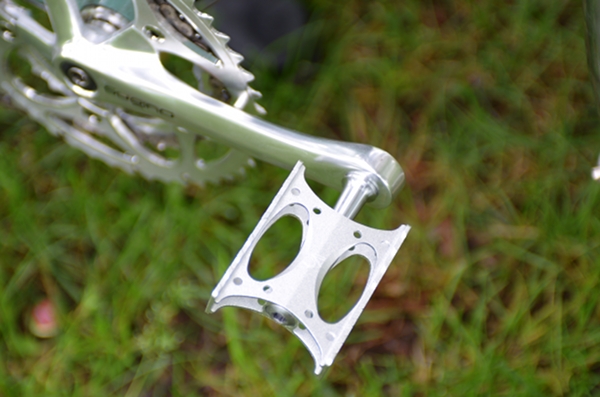
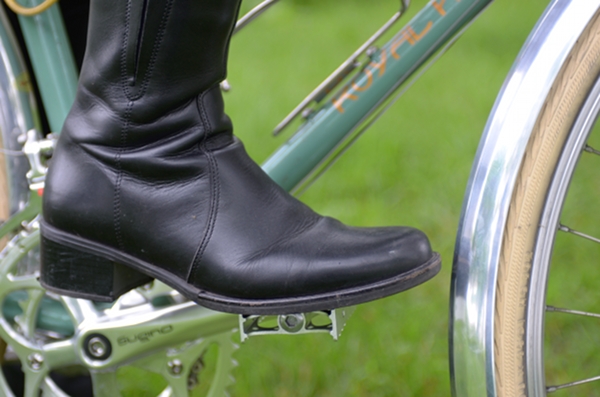
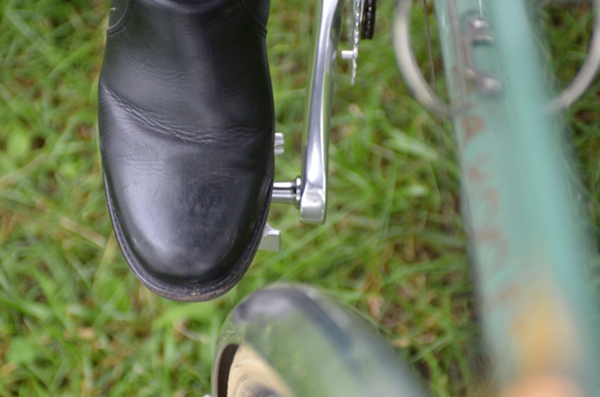
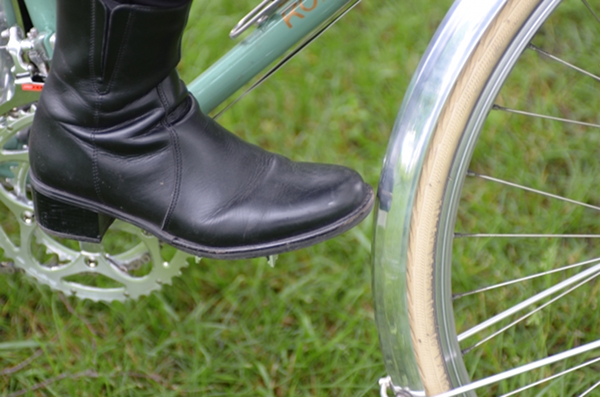
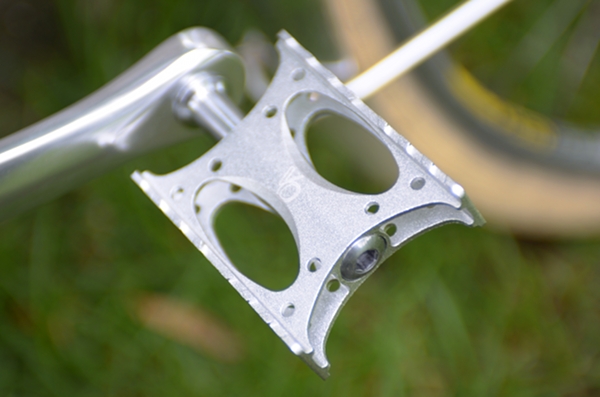

I am 190 cm and my first cranks were 175mm. When I switched to 170mm cranks I have noticed noticable difference in terms of smoother pedal ciycle.
ReplyDeleteCrank length is important on unicycles. I'm not extreme by any stretch, and I still go from 175mm on my off-road unicycle for high torque and control, to 150mm on my 36er, to 125mm on my 24" cruiser/skill uni. Some 36er road fanatics will use cranks as short as 89mm, but I like to be able to use the 36er on easy trails as well as on road. Still, after riding the 125mm on the 24", the 150s seem a bit long, and the 175s are ridiculous. It's definitely easier to be smooth on shorter cranks, at least on unicycles.
ReplyDeleteUm... offroad unicycles?
ReplyDeleteGo on.
Honestly I'm really very surprised that despite all of your recent experience with cycling over the last year you are still so 'psyched out' by toe overlap.
ReplyDeleteIt can be scary for beginners to know that your toe can whack your front tire if you're not careful, but like when you first learn to drive a stick and realize if you're not careful you can shove it into reverse, after practice it's really not an issue.
Try and take a deep breath and not let things like that worry you so much (yes it's hard to do!)
------
As far as crank length, I've read a couple of reports done using power meters and if I remember correctly most seemed to put out more wattage with the longer cranks. Though that doesn't necessarily have anything to do with comfort or smoothness. *shrug*
Ditto wow reaction re the off road unicycle : )
ReplyDeleteJammy - I am not so much psyched out by it, as just plain don't like it. It's a personal preference, and it's only natural that I'd want my bikes to be in accord with my personal preferences.
Jammy - there are also experienced drivers, who are proficient at driving manual, but prefer automatic because they find it to be a pain in the butt.
ReplyDeleteI switched from 170mm to 165mm on my Surly Cross Check, on the advice of my physiotherapist and professional bike fitter. This had nothing to do with toe overlap (which I did - and still do - get but only with mudguards fitted). It was purely to "open up" the knee more by reducing the angle of the knee at the maximum degree of flexion. 5mm is small but significant. I had the cranks swapped out at the same time as the handlebars and stem. When I pulled away from the bike shop, I was so taken with the new position at the front of the bike, I'd actually forgotten about the change to the cranks. After a few miles, I suddenly realised that my knees felt just that little bit "less under pressure". This was at the end of March. Nearly 600 miles later, I can report that all the changes have been a resounding success, including the shorter cranks.
ReplyDeleteRebecca
aka rebecca19804
(For some reason, I'm not able to log in and post as myself today!)
I am with Jammy on the toe overlap. If one isn't going very slowly and turning, the bike is counter steered slightly to start the turn and then leaned more than steered into a turn. Given your desire to learn use clipless, I would suggest you do find a bike without toe overlap when starting to practice with the clipless - perhaps a bike without fenders.
ReplyDeleteOf 165mm, I've not tried them, though I've heard a shorter crank a) spins faster and b) has less hill climbing torque and c) is less prone to pedal strike. I feel about pedal strike like you feel about toe overlap. That was one reason I didn't like a Brompton I used to ride. Hard pedal strike can lift the rear of the bike which can be disconcerting in a corner.
I've heard conflicting theories on crank length, but the general concensus seems to be that the shorter the crank, the healthier it is on the knees since they don't have to bend as much before the power stroke. Of course, this also depends on leg length. Shorter cranks also promote spinning. The tradeoff is that you generate less torque to the drivetrain. No big deal, you just compensate by using slightly lower gearing and pedaling faster to arrive at the same speed.
ReplyDeleteAs for the residual toe overlap that you might experience on this bike, it's not nearly as big a deal as TCO using retention. The few times I've had toe overlap without retention because I've planted my foot sloppily, the fender just nudged my foot out of the way without affecting the bike's stability-- something that can't happen with retention.
I saw this pics go up an flickr and have been waiting for this post. I think they are pretty too!
ReplyDeleteSo where's the "Lovely Unicycle" blog, Aaron? I've still never gotten the hang of one of those things, but I've often thought that, since I'm too big for most folding bikes, a unicycle would make a great dual-mode commuter vehicle, since it'd be easier to squeeze on a bus or train.
ReplyDeleteAnyway, as far as crank length goes, most of my bikes have 175mm cranks, but when I built up my fixie, at the advice of a buddy of mine who's a veteran racer (50+ years in various disciplines and still winning, so I take his advice seriously) I used 170mm cranks.
Honestly, I can't feel the difference. I've used it with clipless pedals, toe clips and flat pedals and it's been fine.
I suppose there's an apples/oranges factor in that, though, the fixie obviously rides differently and offers a different body position than my other bike, so a few mm difference in crank length is a minor factor. What I'd need to do, if I weren't flat broke, is try a couple different cranks on the same bike and see if I could tell, but I doubt I'd feel much difference at less than 10mm.
The smaller pedals don't affect overlap because it is your foot that is hitting the wheel, not the pedal. The pedal axle is in the same place regardless of pedal size, and one places her foot in relation to the axle. of course, this isn't to say that there aren't other reasons to like the pedals.
ReplyDeleteAaron, are you the extreme unicycler on youtube?
ReplyDeleteErik - I understand this in principle, but to me it distinctly feels that my foot is a bit further back with these pedals. Could very well be imagining it.
ReplyDeletesomervillain - Which of your bikes have toe overlap? With such large sized frames I am surprised.
ReplyDeleteI have a related question. I am building a bike for my daughter, who is short -- under 5 feet -- and the cranks I ended up using from the bike co-op were 170 mm. Do you think 165 mm would work better for a short person?
ReplyDeleteOk, apparently off-road uni -- aka, "mountain uni" or "muni" -- is not as well-known as I thought. Living in Boulder, CO, one can't do anything that everybody hasn't seen before, but I guess the rest of the country can still manage to raise an eyebrow or two once in a while.
ReplyDeleteAnyhow, for those interested, google "Kris Holm," "Dan Heaton," or "Terry unigeezer" to see various extreme off-road riders. Kris has a (relatively) major company that makes top-of-the-line cyles, although one can of course get titanium or carbon fiber frames from independent builders. Googling "unicycle trials" also shows another extreme form of uni, although I always wonder why they don't just use pogo sticks (kidding, though you'll see what I mean).
For commuting, a unicycle can indeed be great. I don't mix public transportation with cycling, preferring instead to bike everywhere, but I've often thought that it would be cool to live somewhere that a 24" or 26" commuter would make sense. I'll occasionally commute on the 36er (that's a uni with a 3' diameter wheel -- google "unicycle in manhattan" for a fun 36er video), but it wouldn't mix well with public transportation.
For those who like to lay out cash, there's even the option of an internally geared hub. Because an IGH for unicycles has to work both forwards and backwards, there's only one in production, and it costs on the order of $1500 and is a pain to get. But those who have it love it. The current one-hour record (30km in one hour) was accomplished on a 36er with an IGH. More folks have gotten into touring, as well, on them -- whereas previously only hardcore nutcases toured on unicycles. I like my unis simple, though, so no IGH for me.
All in all, I recommend that anyone who loves bicycling learn to unicycle. It adds variety and improves handling skills. And there's no chance of toe overlap!
I am 5' 2.5" and I have 155mm TA Carmina cranks on my touring/commuting bike. I have used both 165mm and 155mm cranks on multi-day tours through hilly New England, and I definitely find the 155's to be easier on my knees.
ReplyDeleteJon, based on my experience, I would recommend the shortest cranks you can find for your sub-5-foot daughter.
Love the pedals, great look!
ReplyDeleteI just send you an email. I used "ruffly" instead of roughly. I feel like an idiot...i'm sure there are plenty of typos!
Thanks so much
I swapped from 175mm to 165mm to cure
ReplyDeleteoverlap (which it did). I also like
the feeling of the short cranks and
the fact that it reduces the maximum
bend of my knees.
The only downside is that I had to
raise the saddle 10mm, which makes it harder
to put a foot down when stopped. Of course
this reduces the maximum knee bend even further,
so that is good (for me).
My other bike is still 175mm and I swap
between them regularly. At first I could
feel a bit of a difference, but not any more.
The body is adaptable.
John I
A lot of fixed-gear fans select the shorter crank arms in order to minimize heel strike. Is that the case with your Moser?
ReplyDeleteMT cyclist - Yes, the Moser in his current incarnation has 165mm cranks (assuming you mean pedal strike). It has such a low BB, that I am wondering whether the original cranks were the same, despite it not having been fixed gear.
ReplyDeleteI used 170mm for the first decade of my career, because my first "real bike" had them, but then I tried 175mm and found that I just had to have them on ALL my bikes. I really thought it was crucial and I had to have that extra 5mm across the board. Many years later I set up a fixed gear 3-speed hub and wanted to use some classic Campy track cranks I had on hand, which are 165mm. Generally one uses shorter cranks on fixed gear, but I suspected that a full one centimeter shift away from my norm would feel totally weird, and probably uncomfortable. Lucky for me, I found I like it just fine, have no issues whatsoever, and it is probably even easier on my knees. Recently I borrowed a tandem long-term and it has 170mm cranks. It feels great, too. Ditto for 1200+ "spinning" classes I have taught on 170mm cranks: works great! I suspect this is like most differences between bikes: we adapt quickly and don't really notice.
ReplyDelete"The only downside is that I had to
ReplyDeleteraise the saddle 10mm, which makes it harder
to put a foot down when stopped."
Yes, good point. But I find it easier to stretch my "foot down comfort zone height" on a light weight bike, so I haven't had problems stopping and starting in traffic on this mixte. Might raise the saddle some more actually.
Jon Webb - Yes, probably everyone would agree that 165mm cranks (or shorter, if you can find them!) would be better for her.
D'oh!
ReplyDeleteYes, I meant to say "pedal strike."
"For commuting, a unicycle can indeed be great"
ReplyDeleteI've seen at least one unicycle commuter in Cambridge, MA, and a couple more on the Minuteman trail in the vicinity of Arlington/Lexington. They looked like it was the most natural thing in the world to be doing, as others stared with their mouths agape : )
Toe overlap nearly got to me numerous times especially cranking uphill on a loaded bike with traffic coming from behind. This is worth repeating: "As for the residual toe overlap that you might experience on this bike, it's not nearly as big a deal as TCO using retention. The few times I've had toe overlap without retention because I've planted my foot sloppily, the fender just nudged my foot out of the way without affecting the bike's stability-- something that can't happen with retention." summervillian
ReplyDeleteDon & somervillain - I completely agree that TCO *with* foot retention is worse.
ReplyDeleteWhat I meant in the post was that with foot retention, whether you have toe overlap or not is unambiguous: your foot does not change positions on the pedal. So I can get on a bike, stick my feet in the Power Grips, and know with 100% certainty that I will not hit the front wheel with my toe no matter what.
No paw overlap is one of safety bicycle principles. I was promised no paw overlap when I traded in my peppy farthing.
ReplyDeleteI changed the cranks on my cross-check from 175 to 165 and found it noticeably easier to pedal at higher cadence and to use the drop bars. I think this is because I get less of the "kneeing myself in the gut" feeling with the shorter cranks.
ReplyDeleteMore recently, I put the 175 crank back on the right side only, leaving the 165 on the left, because my right leg is a couple centimeters longer than my left. This makes my knee extension at the bottom of the pedal stroke feel more balanced, but I might have to go back and forth a couple times to decide whether I like 165/175 or 165/165 better overall.
I'm 5'7" tall, for reference.
Oh yeah, if you want to experiment with crank length and have a normal, square, bottom bracket, take a look at the "bulletproof" or "origin8" brand cranks. (try amazon.com, or other places). They come in a zillion sizes and are cheap. If you get a silver one with the ugly lettering, fine sandpaper removes it nicely.
somervillain - Which of your bikes have toe overlap? With such large sized frames I am surprised.
ReplyDeleteOnly one of my bike has TCO, my smallest frame: 60cm Raleigh comp. But that has retention, which makes it more of an issue. The bike that I experienced overlap with using regular platform pedals and no retention was my too-small 58cm Shogun, which I no longer have. That's the one I was referring to in my comment above. Also, I wear size 47 shoes!
I just got back from a 45 mile ride trying clipless for the first time ever, and I checked to make sure there was no overlap. Phew! With my size 47 SPD shoes and the clip adjusted mostly forward, I have no overlap. It clears by just a couple mm at the closest point.
I was looking forward to more of a write up, first time ever clipless @ 45 miles. :)
ReplyDeletePerhaps coming soon? This would be the place to do it.
That came out sounding wrong. You can "do it" somewhere else and maybe link from here?
ReplyDeleteNot a bad idea, MDI, but isn't clipless the antithesis of "retro"? :-)
ReplyDeleteI may do that, anyway. I mean, the bike the clipless setup was on is certainly retro enough.
I don't think this looks any less retro with the new clipless pedals.
ReplyDeleteOnce I replaced my 170 mm cranks with 175 mm cranks without thinking much about crank length (there was only one length available). I was then „rewarded“ with knee problems, so I had to replace them again.
ReplyDeleteZweiradler - What kind of bike was this?
ReplyDeletesomervillain - I am still surprised that you are getting TCO with 58cm and 60cm frames; I thought those sizes were "safe." MDI's 58cm Motobecane had no toe overlap, while my 53cm had it dramatically.
There are websites with measurements for crank length, some believe it's just based on standover height, others have a complicated formula based on leg length and this and that. Either way, based on your height, 165 might be a bit short, or at least as short as you should go. It might improve the spinning and if you have 165 on other bikes you know the difference and if it works for you or not.
ReplyDeleteI should be at about 160-162 which is rare and impossible to find. 165 is the shortest most manufacturers go to which would be okay for touring. 170mm is the standard size that bikes come with regardless of bike frame size. So many people either have cranks too short or too long and do not know it.
I have problems with over extention, trouble with cadance and spinning, and get bummed out because I never get that swoosh swoosh road bike feeling. My bikes all have the stock 170mm cranks except for my beloved raleigh with very short cranks-too short for even me, but the difference is striking(hee hee).
165 only decreases knee pain/problems, improves spinning etc if it is the 'right' size for you.
I realize you want to fix toe overlap, but sometimes it's about the feet and the frame dimensions regardless of pedals and cranks. I hope this quick fix works before going to more drastic measures. I absolutely love Constance!
and where did Lisa find 155mm TA cranks?
MDI's 58cm Motobecane had no toe overlap, while my 53cm had it dramatically..
ReplyDeleteHis Moto had a long top tube (most French bikes did)-- a major determinant of whether there will be TCO. Also, what size shoe does he wear?
A couple quick comments before I read through everyone above--
ReplyDeleteI did some mountain bike racing last year, and one of my most bizarre (and ignominius) momnets was when I got passed by a guy on a unicycle.
As for toe overlap, I'm with V, it just annoys the heck out of me. I notice it much more with city cycling as opposed to the open road, naturally. I have no motivation to put up with it if there's a reasonable solution.
Heather -- my 155mm TA cranks came from Peter White Cycles (www.peterwhitecycles.com). They were expensive, and buying them was a leap of faith on my part, but after a year I can say that I think they were worth the price.
ReplyDeleteI like bikes with longish top tubes. Motobecane was 57cm. Surly is 61cm. Bike shoes are size 10.5 or 11, or even 11.5, I forget. I tried a bunch on and bought ones that fit. Bike shoes sizing is its own thing. My regular shoes tend to be 10.5 or 11.
ReplyDelete@ Velouria:
ReplyDeleteIt was my current bike, I guess it's called hybrid (or "trekking") bike. My knees still get bent over 90 degrees, that’s why I intend to try 152 mm cranks soon (found some cheap ones).
Good call, you might not like the handling after re-raking your fork. Going to a smaller wheel would drop your bottom bracket height (keep your inside pedal up in corners!), but might be a good thing for casual riding - feet closer to the ground when stopped.
ReplyDelete